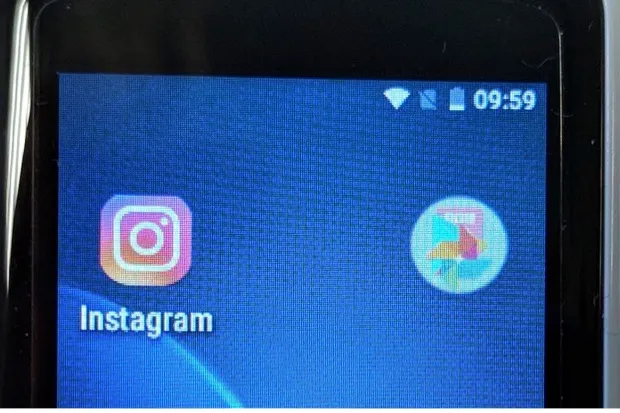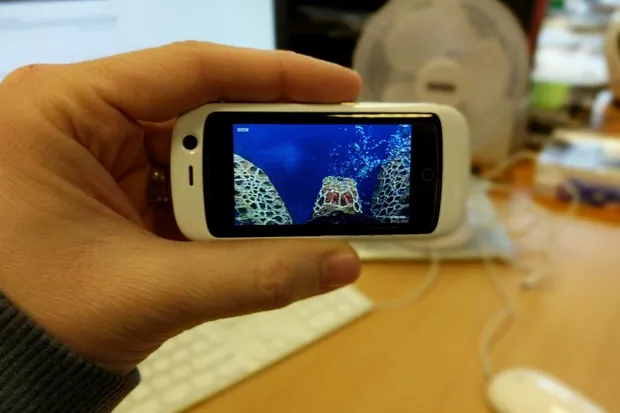Remember back in the early 2000s when Dom Joly used to prank the public with hisenormous, oversized mobile phone? Well now that I’m hauling a Google Pixel XL around with me it sort of feels as if life is imitating art (even if, I hope, I’m a little more discreet when it comes to answering the thing). So, it’s quite refreshing to see someone try to take us back to an era when we tried to make phones as comically small as possible. Back in the day, all you really needed was enough screen real estate to read text messages – now, if you want your smartphone to be taken seriously you need to have a touch screen and at least a relatively up-to-date version of Android. You might not have heard of Unihertz, but their Jelly Pro smartphone has probably the bare minimum of those requirements - Android 7.0 crammed behind a tiny 2.45-inch screen. So, does a phone that fits in your coin pocket actually make any sense in this big phone era?
Fun size phone
Yep, once you get it in your hand you realise that the Jelly Pro is really, really small. Not since I toyed with aNokia 7380back in 2005 have I’ve picked up a phone this tiny, and I’ve practically forgotten how to hold something so small, let alone use it. At 92.4x43x13mm it’s barely bigger than a matchbox, so it will comfortably slip into your coin pocket, but this is actually pretty important because, oddly, the 13mm depth makes it bulky compared to the 8.5mm Pixel or 8mm Galaxy S8. In said coin pocket it’s kept pretty snug, but in your regular pocket it feels weirdly obvious. The size also means that you have to re-evaluate how you hold a phone when making calls; my hands began to ache after a short while due to the now-unnaturally cramped position of my hands. It does have Bluetooth 4.1, so using a hands-free headset is probably the best way to make calls (in fact I tested out a few of thesetrue wireless headphoneson it), but this probably had an impact on the battery life – more on which later.

Aesthetically, its build is definitely geared to keeping the price down. The basic plastic case, which you feel you almost have to snap off to get to the battery and dual SIM card slots, has a bezel that is pretty big in comparison to the screen. I found that as it’s a little bulkier than current phones, I couldn’t help but think it’s a slide phone, and I found myself instinctively trying to push the screen up - that’s not something I’ve had to do for the best part of ten years (and clearly miss). It’s also very light, and it slipped out of my coin pocket a couple of times when taking my wallet out, and I barely noticed it wasn’t there.
Micro droid
When it comes to how it works as a smartphone, there are some fairly obvious things you have to get your head around before you get comfortable with it. Given the screen resolution is only 240x432 pixels, the text and keyboard is almost absurdly tiny. There is software to make it more legible and on the whole it does a reasonable job, but it is still eye-squintingly small at times, especially if you use the bundled web browser (Chrome is much clearer). Typing messages is probably about 70 per cent accurate, which given the minute keys seems like a pretty good return, but eventually I ended up giving up typing anything and resorting to using voice search/keyboard.
As you would expect this doesn’t have the fastest processer under the bonnet (1.1GHz Quad Core with 2GB RAM to be precise), so things are a little slower than I’m used to, but still the battery life drained far too quickly. I was never anticipating doing anything more than absolutely necessary (great if you’re doing a tech detox, more of which can be found inissue 317of BBC Focus), but general web browsing, listening to music and a call or two ran the battery down before I got home from the office. A representative from Unihertz told me that the Jelly Pro isn’t supposed to replace your regular phone, but in my experience its battery life is just too short to make it a viable backup. Maybe it was the 4G sucking up all the battery power, but if just staying connected is going to drain it so quickly why have a dual SIM slot? Personally, I can’t imagine a situation where a backup phone with two SIMs is necessary, especially one that can’t last the day.

Android itself actually works pretty comfortably - it’s obviously not designed to work on a screen this small, but it can. Don’t bother putting things into groups on your home screen as it’s impossible to know what’s in there and a few screens in the Play Store can’t handle the resolution, but on the whole, it’s manageable and everything works reasonably well. This is significant as it means that the whole concept of a micro smartphone isn’t dead in the water. It has much of what you would expect on a smartphone - micro SD port, Wi-Fi, front and rear cameras (2MP and 8MP respectively), Micro USB, accelerometer, even a 3.5mm headphone input – so maybe with an optimised version of Android rather than the vanilla one things could be significantly more usable, especially when it comes to typing.
Vital stats
Cost: $124.99 (around £90),unihertz.com/jelly
Dimensions: 92.4x43x13mm
Weight: 60.4g + battery
Colours: Pearl White/Space Black /Sky Blue
Operating system: Android 7.0
CPU: Quad Core 1.1GHz
RAM: 2GB(Pro)
Battery: 950mAh
Display: 2.45 inch
Resolution: 240x432 pixels
Camera: 8MP (rear), 2MP (rear)
Verdict
Despite all of its shortcomings, I actually really wanted to like the Jelly Pro. I spend pretty much all of my day staring at screens, and having a sizable phone constantly vying for my attention doesn’t help me to switch off in any way. The idea of a phone that would help me limit the amount of time I spend prodding away at it, while still giving me the functionality to read WhatsApp messages, switch my Hue lights on and generally stay in contact with people is tempting - but it isn’t this phone. Maybe with improved battery life and a more premium feel in the next version of the phone, I might be persuaded. In fact, it could even be a little larger to accommodate this.
Ultimately though, if you expect little more than having a little Android phone, there are no littler ones than this – there are, however, many better ones.

